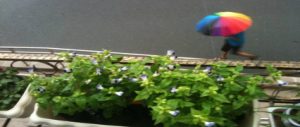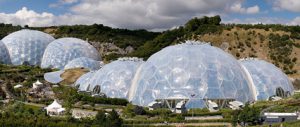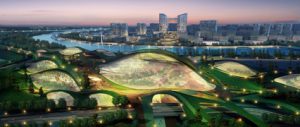When David Green gets up in the morning, the first thing he does is check the sky. If it is sunny, he likes to nip outside and charge his electric car, or put on a load of washing.
“It costs me nothing when the sun is shining,” he says, thanks to a bank of solar panels on the roof of his 1870s house in Cowes on the Isle of Wight, in the English Channel. For much of the year, running a hot bath is free, too (bar the installation costs), because of a separate solar thermal water heating system.
Green is plotting to shrink his carbon footprint even further by putting in a few small wind turbines and a computerised home-energy system that will tell everything from the fridge to the television what to do.
But for the happily named Green, a former public relations and charity executive, this is piffling. If he has his way, all 140,000 residents of the Isle of Wight will soon be doing something similar, as their pretty home off the southern coast of England is turned into one of the world’s biggest “eco-islands”.
Green, 50, has turned himself into the chief executive of the EcoIsland Partnership Community Interest Company, a body set up to bring the eco-island vision to life.
Backed by 70 companies, including IBM and Toshiba, the group hopes to make the island not just energy independent, but so rich in renewably generated power that by 2020 it will be a net exporter of energy, selling it back to the British mainland, five kilometres away.
The plan, launched in a splashy event in London late last year, makes the Isle of Wight the latest member of a small but growing club of islands that aim to go green. For some, the move has been transformative. For others, it has proved more troublesome. Most intriguing, though, is the fact that it is happening at all.
The phrase “eco-island” did not start appearing in newspapers until 1991, when a computer game called Eco-Saurus was launched to encourage children to save an imaginary eco-island from environmental doom.
Today, it has taken off in real life and from Scotland to Portugal, from Thailand to Azerbaijan, eco-islands are either under discussion, in development or under way.
One of the best known is Samsø, a Danish island in the North Sea. In the late 1990s, to the surprise of many of its 4,300 inhabitants, it won a competition the Danish government had launched to find a showcase community for renewable energy.
One islander, an environmental studies teacher named Søren Hermansen, was inspired. He became the project’s first employee, thanks to some federal funding, and began coaxing his neighbours to think about buying shares in wind turbines, and consider solar panels instead of oil heaters.
Between 1998 and 2001 the islanders halved their use of fossil fuel, and by 2003 they were exporting electricity back to the mainland instead of importing it.
Today, those exports bring in some 40 million Danish kroner a year for the islanders, or around US$7.1 million, says Hermansen, who has become a global green-energy oracle, consulted by academics and officials around the world and chosen as a 2008 “Hero of the Environment” by Time magazine.
“A lot of the money goes to paying back the bank loan for the turbines,” he says, but the rest is used to invest in more clean energy on the island.
Greening has gone less well in China.
In 2006, a place called Dongtan on the island of Chongming at the mouth of the Yangtze River was promoted as the world’s first sustainable city. In the words of one official, the Dongtan eco-city would become “a tourist heaven”.
Four years later, the project had stalled amid confusion over who was going to pay for it; the political woes of some of its backers and, according to some, a failure to adequately consult the local community.
Today, the word “Dongtan” has become synonymous with greenwash: a pile of exaggerated claims about the environmental benefits of something that turned out to be nothing so grand.
And then there is Eigg.
The Isle of Eigg, which is pronounced “egg”, off the west coast of Scotland, did not go off the grid for its electricity, as such. It was never on the grid in the first place. Up to the late 1990s, the 60 or so people then living on the island relied mostly on messy, noisy diesel generators, fuelled by supplies brought in by boat.
“Getting diesel in was a hell of a palaver,” says Maggie Fyffe of the Isle of Eigg Heritage Trust. The intermittent power supply was a challenge, too.
“If you got up in the middle of the night, you would need a torch by your bed,” says Fyffe, who helped drive a 1997 buyout of the island that set it on a low-carbon path.
A mix of hydro-electric, wind and solar power was installed and, when it was hooked up in 2008, it gave the islanders 24-hour power for the first time – as well as appliances that most of us have taken for granted all our lives. Fyffe, who was honoured by the UK government for her efforts, finally got her first washing machine.
People still have to be careful about how much power they use, especially if the rivers are running slowly or the wind is weak. A traffic light is about to be installed on the island pier, with a green and red light to tell people if they need to ease up on electricity use. But considering what conditions were like before, there are few complaints.
Whether the Isle of Wight’s eco-island plan will follow in the steps of Samsø, Eigg or, dare it be said, Chongming, is unclear at this early stage of the project’s life. What seems evident is that, if it does succeed, it will be in a different form to others. For one thing, there is such fierce resistance to large wind turbines on the Isle of Wight that they are unlikely to be part of the eco-island vision, says Green.
“I understand how people feel about them,” he says. “They are very big and very imposing on the landscape.”
His funding model will also be an eco-island test case because, unlike other UK government-backed models, it has been very much a private sector initiative so far. Some of the companies backing the concept will use the island as a “living laboratory” to test their latest equipment, says Green.
Eventually, he hopes, that means people will control their household appliances from an iPhone application, “so you can give it instructions that you want your beer fridge on two hours before your [friends] come around”.
Eco-islands around the world
Gotland, Sweden. Has hopes that by 2025 it will get all its power from wind, solar, district heating and other environmentally friendly sources, and plans to keep investing in similar.
Moskito, British Virgin Islands. Bought by the British tycoon Richard Branson, who wants to turn it into the world’s most environmentally friendly island. He plans to build a number of villas and a restaurant for a resort on the island powered by wind turbines and solar panels. Food will come from an organic orchard; beach buggies will be powered by biofuels and buildings will be designed to capture cool thermal airflows so there will be no need for air conditioners.
Graciosa, Portugal. Scheduled to trial a mix of wind and solar backed up by battery storage technology, which its German backers hope will revolutionise clean energy.
Zira, Azerbaijan. Danish architects BIG have been hired to create a zero-carbon city using offshore wind, heat pumps connected to the surrounding Caspian Sea, solar water heating and PV panels.
Miyakojima, Japan. Already uses wind and solar power, and Toshiba has installed state-of-the-art systems to integrate intermittent power, generated by green technology, with the island’s conventional grid supply.
Pilita Clark is the Financial Times environment correspondent.
https://www.ft.com/home/uk
© Copyright The Financial Times Limited 2012
Homepage image by Nick Wilson shows a solar panel on the remote Scottish isle of Eigg, which uses a mix of solar, wind and hydro-electric power.


